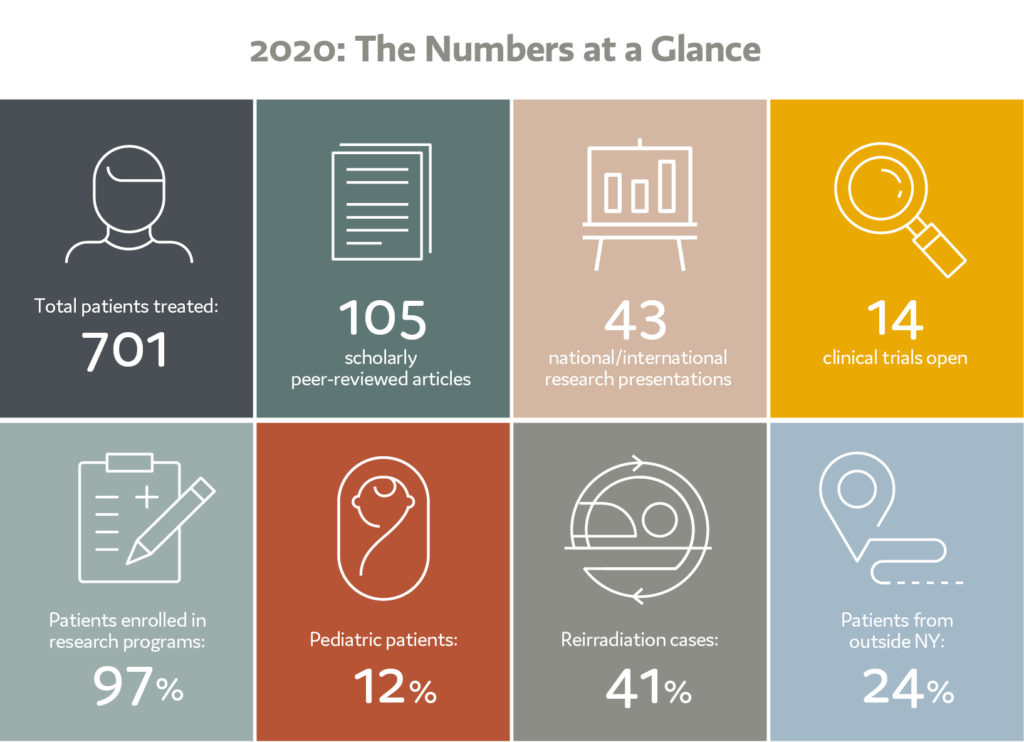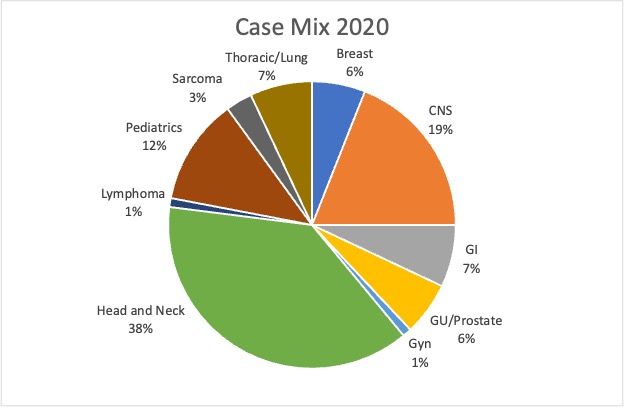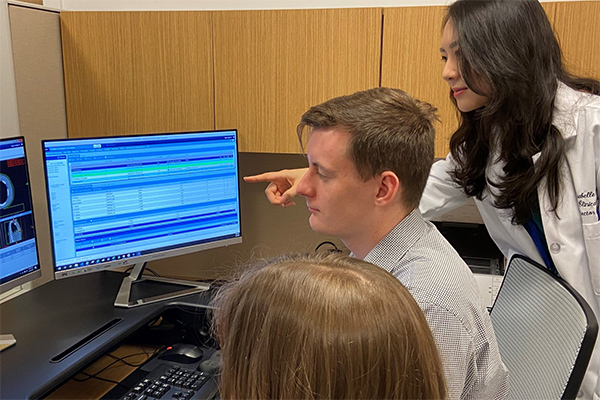NYPC 2020 Year in Review
Tested by COVID-19
And emerging stronger than ever.
Post-COVID Outlook
Despite the extraordinary uncertainty brought on by the coronavirus pandemic, the New York Proton Center ended the year 2020 with a record of unprecedented growth, far-reaching accomplishment and—as we look ahead—broad optimism about our prospects in a post-COVID future.
Though our volume predictably fell during the early stages of the pandemic, it had almost fully recovered by year’s end to nearly 100 patients per day. That number includes patients who, due to the uniquely challenging nature of their cancers, were referred to us by our hospital partners. Because these patients urgently required proton therapy, we took extraordinary measures to treat them without delay—most importantly, by taking extensive precautions to keep our facility safe against COVID-19.
NYPC Staff: Unwavering Dedication
We’d especially like to acknowledge our remarkable staff. Even in the face of unprecedented hardship, they never wavered in their dedication or perseverance.
We’re also deeply grateful to our partners: Memorial Sloan Kettering Cancer Center, Montefiore Health System and Mount Sinai Health System. From day one they worked together—and worked with us—to bring this life-saving cancer treatment to the residents and communities of greater New York.

A Record-Setting Year
Since opening in August of 2019, we’ve experienced the fastest ramp-up of any proton center in the country—an especially notable accomplishment given our sharp drop in volume at the peak of the pandemic.
By August 2020, the end of our first year of operation, we had treated nearly 540 patients in our four treatment rooms—making us one of the busiest centers in the U.S. and the fastest – by a wide margin – to ever reach that milestone.
We’ve also become the national leader in treating patients with complex cancers. It’s an accomplishment we largely credit to our highly experienced clinical team and to our hospital partners, who recognized the need for a single facility where their patients, and others in the region, could receive proton therapy without traveling far from home.
We exceeded national averages in other areas as well:
- Reirradiation, which is primarily performed on adults, represents 41 percent of our patients. The national average for proton centers is 11 percent. Reirradiation can provide patients with recurrent cancers a new chance of cure.
- Stereotactic Body Radiation Therapy, also known as SBRT, represents 8.3 percent of our case load. That’s nearly 12 times the national average of 0.7 percent. SBRT uses very high doses of radiation to deliver ultra-precise, highly effective ablative treatments.
- Head and neck tumors accounted for 38 percent of our cases in 2020, compared to 13 percent nationally. These tumors can be especially challenging to treat due to their proximity to critical organs and structures such as the optic nerves, brainstem, vocal cords, salivary glands and brain.


At The Frontier of Research
In just 18 short months since treating our first patient, the New York Proton Center has established itself as a leader in proton therapy research. We are dramatically expanding the evidence supporting this potentially lifesaving treatment, with the ultimate goal of making it more widely and readily accessible to patients.
For that reason, all patients at the New York Proton Center are given the opportunity to participate in one of our prospective clinical trials—as 97 percent of them did during 2020. This included adults who took part in either our treatment-intention trials or in a prospective multicenter registry trial from the Proton Collaborative Group (PCG), as well as children who participated in the Pediatric Proton and Photon Consortium Registry (PPCR) or in one of seven Children’s Oncology Group trials.
By January 2021, the center was actively enrolling patients in 14 research trials, nine of which were added in late 2020. They include:
- Three phase III proton versus photon randomized trials (breast cancer, lung cancer, and head and neck cancer)
- One consortium phase III prostate trial
- One cooperative group phase III head and neck trial
- One cooperative group phase II breast trial
- Five investigator-initiated trials in head and neck cancers, central nervous system metastasis and pediatrics/neuroblastoma
- Three registry trials
Other Accomplishments From 2020:
- Our physicians published 105 scholarly, peer-reviewed articles last year. They also delivered 43 national/international research presentations at 11 national or international meetings, including the American Society for Radiation Oncology Annual Meeting in October and the Particle Therapy Co-Operative Group Annual Meeting in September. These presentations assessed outcomes and novel applications involving the use of proton therapy across many types of cancer, as well as the impact of COVID-19 on patient care.
- The 2020 ASTRO Annual Meeting featured 15 oral presentations and posters by our radiation oncologists and physicists. Topics included non-small cell lung cancer, mesothelioma, breast cancer and reirradiation. Our Chief Medical Officer, Dr. Charles B. Simone, II, presented an invited lecture at the ASTRO conference entitled “Addition of Immunotherapy to SABR for Early Stage Non-Small Cell Lung Cancer.”
- Dr. Simone also presented at the Presidential Symposium of the annual meeting of the Radiation Research Society, the largest organization dedicated to translational research in radiation oncology. His presentation on ultra-high dose (FLASH) radiotherapy was entitled “FLASH: An Exemplar of Multidisciplinary ‘Transgenerational’ Radiation Research.”
- Our center received three grants to study FLASH radiotherapy from Varian Medical Systems. We also received an NIH grant—“Automated Object Contouring Methods & Software for Radiotherapy Planning”—to research contouring of critical organs that are at higher risk of toxicity during treatment.
A First-Of-Its-Kind Training Program
In September 2020 we became the first proton center in the world to launch a comprehensive “Proton Therapy School.” Sponsored by Varian and led by our in-house experts, the program educates clinicians worldwide—including physicians, physicists, dosimetrists and therapists—on using and delivering pencil-beam scanning proton therapy. It’s the same sophisticated and highly precise technology that we use at the center to treat particularly challenging tumors.
After training numerous proton clinicians throughout the U.S. in 2020, the school expanded internationally in January 2021 with a training program for clinicians from the Hefei Ion Medical Center in Hefei, China.
A New Leader, Steering Us Into a New Era
On January 12 of this year, the New York Proton Center announced the appointment of our former CFO, Jonathan Weinbach, as our new Chief Executive Officer. He will succeed Al Freeman, who—having provided essential leadership throughout our successful launch and robust initial growth period—has now transitioned to a special advisory role.
“Jon’s strong commitment to the center, energetic leadership and keen intuition for what drives growth and innovation has already been a critical part of its success and will ensure the New York Proton Center becomes a case study in proton therapy’s potential to become a new standard of radiation care,” said Donald Scanlon, our chairman of the board.
Jon assumes leadership at the New York Proton Center during what he describes as “a pivotal moment for cancer providers across the country.”
I’m proud we remained safely open for our patients throughout 2020, and I am confident we are positioned for continued growth as we meet the demand of New Yorkers and those around the world seeking the best radiation treatment available to them.
– Jonathan Weinbach, Chief Executive Officer
